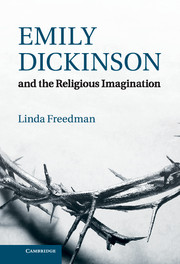Compound vision
Published online by Cambridge University Press: 07 September 2011
Summary
The compound vision of Dickinson’s religious imagination emerges most strongly through the interplay of poetic and religious ideas in four major and interdependent themes: body, mediation, journey and gesture. In Chapter 1, we saw how Dickinson’s poetic concern with embodiment reconfigures the problem of the Word made flesh – the difficulty of holding humanity and divinity together in one relationship. As aesthetic and religious ideas converge in the body long before the nineteenth century, she can be seen to be writing within an informed New England tradition that continued to impact upon the theological and literary terrain she inhabited. Revelation influenced notions of representation and human language from the Mathers through to Edwards, Emerson and Channing at least partly because the incarnation was perceived to be a corporeal signifier of incorporeal meaning.
Dickinson’s Christological reworking of corporeality as a way of understanding the medium of poetry and poetic experience not only provides a foundation for the compound vision of her religious imagination, it also suggests that the nineteenth-century literary obsession with corporeality has a theological component that has been largely overlooked. Dickinson’s strategies of verbal condensation, her depiction of duality as an unexpected and questionable gift, and her sense of the body as both the enabling condition and the limiting constraint of her vision are indebted to the conceptual vocabulary of the hypostatic union and the Word made flesh. Through the conceit of the veil, Dickinson also drew a parallel between incarnation and imagination and in this sense she bridged religious and Romantic poetics. The veil, a religious symbol of the last barrier between man and God and a type for the body of Christ, is also a Romantic symbol for the sublime quality of the imagination. The veil is both a barrier signalling distance and an invitation to enter, somewhat imperfectly, into the presence of an absolute. It is a manifestly corporeal symbol and central to understanding the way religion fed Dickinson’s imagination of poetry as a fleshy form of communication.
- Type
- Chapter
- Information
- Emily Dickinson and the Religious Imagination , pp. 186 - 192Publisher: Cambridge University PressPrint publication year: 2011



